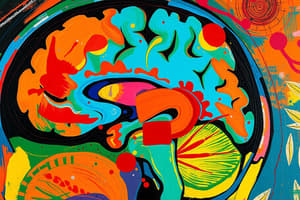Podcast
Questions and Answers
What is the most common risk factor for ischemic stroke?
What is the most common risk factor for ischemic stroke?
- Hypertension (correct)
- Diabetes
- Dyslipidemia
- Atrial fibrillation
Where does an epidural hematoma (EDH) occur?
Where does an epidural hematoma (EDH) occur?
- Between the dura and bone (correct)
- Between the dura and arachnoid
- Within the arachnoid space
- Within the brain tissue
Which symptom is not typically associated with ischemic stroke?
Which symptom is not typically associated with ischemic stroke?
- Loss of vision
- Headache (correct)
- Inability to speak
- Unilateral weakness
What are the non-modifiable risk factors for ischemic stroke?
What are the non-modifiable risk factors for ischemic stroke?
What could be a cause of a complaint of 'the worst headache of my life' in a patient?
What could be a cause of a complaint of 'the worst headache of my life' in a patient?
Who may need to provide a reliable history of a patient's condition in case of neurologic deficits?
Who may need to provide a reliable history of a patient's condition in case of neurologic deficits?
What can cause altered levels of consciousness in stroke patients?
What can cause altered levels of consciousness in stroke patients?
Where do subdural hematomas result from bleeding?
Where do subdural hematomas result from bleeding?
Flashcards are hidden until you start studying
Study Notes
Ischemic Stroke
- Hypertension is the most common risk factor for ischemic stroke
Epidural Hematoma
- Epidural hematoma (EDH) occurs between the skull and the dura mater
Ischemic Stroke Symptoms
- Seizure is not typically associated with ischemic stroke
Non-modifiable Risk Factors
- Non-modifiable risk factors for ischemic stroke include age, sex, and family history
Differential Diagnosis
- A complaint of 'the worst headache of my life' in a patient could be caused by a ruptured aneurysm or cerebral venous sinus thrombosis
Stroke Patient History
- Family members, friends, or bystanders may need to provide a reliable history of a patient's condition in case of neurologic deficits
Altered Consciousness
- Altered levels of consciousness in stroke patients can be caused by a variety of factors including edema, increased intracranial pressure, or metabolic disturbances
Subdural Hematoma
- Subdural hematomas result from bleeding between the dura mater and the arachnoid mater
Studying That Suits You
Use AI to generate personalized quizzes and flashcards to suit your learning preferences.





